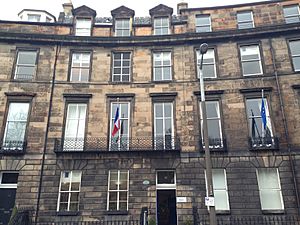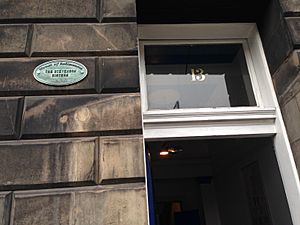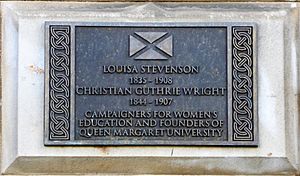Louisa Stevenson facts for kids
Quick facts for kids
Louisa Stevenson
|
|
|---|---|
| Born | 15 July 1835 |
| Died | 13 May 1908 (aged 72) |
| Nationality | Scottish |
| Known for | Campaigner for Scottish women's university education, women's suffrage and effective nursing. |
| Honours | LLD |
Louisa Stevenson (born July 15, 1835 – died May 13, 1908) was a Scottish woman who worked hard to make things better for others. She fought for women to be able to go to university, to have the right to vote, and for nursing to be well-organised and effective. She was even given a special university degree called a LLD for her important work.
Contents
Louisa's Family Life
Louisa was born in Glasgow, Scotland. Her father, James Stevenson, was a successful merchant (a person who trades goods). She had a big family, including her sister Flora, who also worked for women's rights. Her brother, John James Stevenson, became an architect, and another brother, James Cochran Stevenson, became a Member of Parliament (MP).
In 1844, Louisa's family moved to Jarrow because her father started a new business. Later, in 1854, they moved to Edinburgh. In 1859, they settled in a house on Randolph Crescent, which became their home for the rest of their lives. Louisa, Flora, and their sister Elisa were all involved in the fight for women's right to vote, joining the Edinburgh National Society for Women's Suffrage. Because their father left them with enough money, the sisters could help pay for many important causes they believed in.
Helping Women Get an Education
Louisa Stevenson was a key member of the Edinburgh Ladies' Educational Association. This group later became the Edinburgh Association for the University Education of Women (EAUEW). In 1868, Louisa and Flora were among the first women to attend university lectures given by Professor David Masson.
Around this time, Sophia Jex-Blake began her fight to allow women to study medicine. Louisa supported Jex-Blake and helped raise money for her legal costs. Louisa and Flora even paid for their niece, Alice Stewart Ker, to study medicine abroad. Alice later became one of the first female doctors in Britain!
Louisa's work with the EAUEW was very important. She spoke to a special group called a Commission on University Education. Her efforts helped lead to the Universities (Scotland) Act of 1889. This law meant that Scottish universities finally opened their doors to women students starting in 1892.
After this success, Louisa helped raise money for a special place for women students to live at the University of Edinburgh. This place was called Masson Hall, and it opened in 1897. Louisa became its honorary secretary, helping to manage it.
Louisa also helped start the Edinburgh School of Cookery with Christian Guthrie Wright. This school taught important skills like cooking and home management, which was called "Domestic Science" back then. This school later became part of Queen Margaret University.
Improving Nursing and Healthcare
Louisa Stevenson was the first woman in Edinburgh to become a "poor law guardian." This meant she helped manage services for people who were poor or in need. She was especially interested in making sure that nursing standards were good in the poorhouse (a place where poor people lived and received care).
She also helped manage the Jubilee Nurses Institute, which provided nurses to care for people in their homes. She was involved with the Colonial Nursing Organisation, which sent nurses to different parts of the British Empire. Louisa was also the president of a society that worked to make sure nurses were properly registered and trained.
Other Important Work
While her sister Flora was one of the first women to serve on a school board, Louisa was one of the first women elected to a hospital board. She was re-elected six times! Her work was so valuable that she even changed the mind of a male board member who had not wanted women to help run the Royal Infirmary of Edinburgh. Louisa believed that women were just as capable as men at helping to manage hospitals, even if they brought different experiences.
She was also one of the first two women elected to the city's "parochial board" (later called the parish council), where she served for ten years. This board helped manage local community services.
Throughout her life, Louisa Stevenson strongly supported women's suffrage, which is the right for women to vote. In the 1890s, she was a member of the executive committee for the National Union of Women's Suffrage Societies. In 1906, she met the Prime Minister, Henry Campbell-Bannerman, as part of a group of women asking for the right to vote. In that same year, she received an honorary LLD degree from the University of Edinburgh for all her amazing contributions.
Louisa Stevenson passed away on May 13, 1908, at her home in Edinburgh. She is buried with her sisters in Dean Cemetery. People remembered her for her kindness, her strong determination, and her deep understanding of every issue she worked on.
See also
 In Spanish: Louisa Stevenson para niños
In Spanish: Louisa Stevenson para niños




